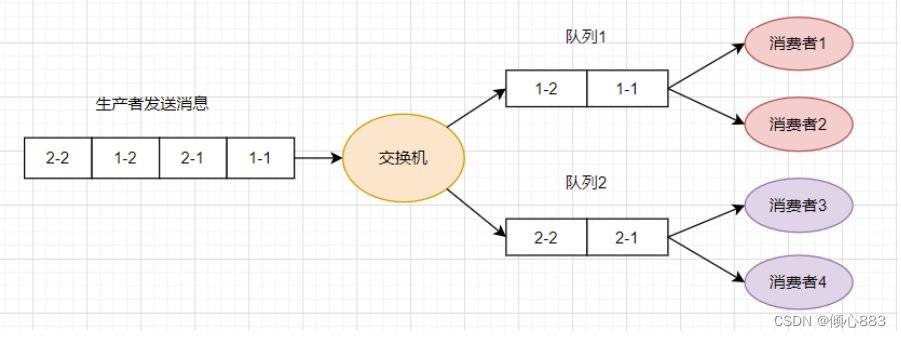一、场景介绍
很多时候,消息的消费是不⽤保证顺序的,⽐如借助mq实现订单超时的处理。但有些时候,业务中可 能会存在多个消息需要顺序处理的情况,⽐如⽣成订单和扣减库存消息,那肯定是先执⾏⽣成订单的 操作,再执⾏扣减库存的操作。 那么这种情况下,是如何保证消息顺序消费的呢?
⾸先,为了效率,我们可以设置多个队列都来处理顺序执⾏的消息。另外,我们需要保证每组顺序消 费的消息发到同⼀个队列中,给这些消息设置⼀个统⼀的全局id即可。
其次,保证消息的顺序消费。就像上⾯所说,⼀个队列对应⼀个消费者即可,但是在项⽬的集群部署 下,这⼜该怎么处理呢?针对这种情况,我们可以设置队列的“单活模式”。
x-single-active-consumer:单活模式,表⽰是否最多只允许⼀个消费者消费,如果有多个 消费者同时绑定,则只会激活第⼀个,除⾮第⼀个消费者被取消或者死亡,才会⾃动转到下 ⼀个消费者
⼆. 模拟代码实现
假设现在我们有两个队列处理顺序消息(消息1-1和1-2属于⼀组需要顺序消费的消息,消息2-1和2-2属 于另⼀组需要顺序消费的消息),每个队列有两个消费者(模拟消费者集群)。

- 队列的配置类
package com.zst.springbootmq.sequence.config;
import org.springframework.amqp.core.Binding;
import org.springframework.amqp.core.BindingBuilder;
import org.springframework.amqp.core.DirectExchange;
import org.springframework.amqp.core.Queue;
import org.springframework.context.annotation.Bean;
import org.springframework.context.annotation.Configuration;
import java.util.HashMap;
@Configuration
public class SeqQueueConfiguration {
/**
* 创建两个队列,处理顺序消息
*/
@Bean
public Queue seqQueue1() {
return creatQueue("q_seq1");
}
@Bean
public Queue seqQueue2() {
return creatQueue("q_seq2");
}
// 交换机
@Bean
public DirectExchange seqDirectExchange() {
return new DirectExchange("direct_seq");
}
// 队列绑定交换机,执⾏路由key
@Bean
public Binding seqBinding1() {
return BindingBuilder.bind(seqQueue1()).to(seqDirectExchange()).with("1"
}
@Bean
public Binding seqBinding2() {
return BindingBuilder.bind(seqQueue2()).to(seqDirectExchange()).with("2"
}
/**
* 创建⼀个 单活模式的队列
* @param name
* @return queue
*/
private Queue creatQueue(String name) {
HashMap<String, Object> args = new HashMap<>();
// x-single-active-consumer 单活模式 队列
// 表⽰是否最多只允许⼀个消费者消费,如果有多个消费者同时绑定,则只会激活第⼀个,
// 除⾮第⼀个消费者被取消或者死亡,才会⾃动转到下⼀个消费者。
args.put("x-single-active-consumer", true);
return new Queue(name, true, false, false, args);
}
}
- ⽣产者
package com.zst.springbootmq.sequence.producer;
import com.qfedu.springbootmq.sequence.message.MessageInfo;
import lombok.extern.slf4j.Slf4j;
import org.springframework.amqp.rabbit.core.RabbitTemplate;
import org.springframework.stereotype.Component;
import javax.annotation.Resource;
@Component
public class ProducerSeq {
@Resource
private RabbitTemplate rabbitTemplate;
/**
* 根据id,将消息顺序发送到对应的队列
* @param id 业务id
* @param msg 业务信息
*/
public void send(int id, String msg) {
MessageInfo message = new MessageInfo(id, msg);
rabbitTemplate.convertAndSend("direct_seq", String.valueOf(id % 2 + 1),
}
}
- 消费者
package com.zst.springbootmq.sequence.consumer;
import com.qfedu.springbootmq.sequence.message.MessageInfo;
import org.springframework.amqp.rabbit.annotation.RabbitHandler;
import org.springframework.amqp.rabbit.annotation.RabbitListener;
import org.springframework.stereotype.Component;
import java.util.Random;
@Component
@RabbitListener(queues = "q_seq1")
public class Consumer11 {
@RabbitHandler
public void onMessage(MessageInfo message) {
System.out.println("c11:" + message.getId() + ":" + message.getMsg());
// 随机休眠
long l = new Random(1000).nextLong();
try {
Thread.sleep(l);
} catch (InterruptedException e) {
e.printStackTrace();
}
}
}
消费者2的代码实现:
package com.zst.springbootmq.sequence.consumer;
import com.qfedu.springbootmq.sequence.message.MessageInfo;
import org.springframework.amqp.rabbit.annotation.RabbitHandler;
import org.springframework.amqp.rabbit.annotation.RabbitListener;
import org.springframework.stereotype.Component;
import java.util.Random;
@Component
@RabbitListener(queues = "q_seq1")
public class Consumer12 {
@RabbitHandler
public void onMessage(MessageInfo message) {
System.out.println("c12:" + message.getId() + ":" + message.getMsg());
// 随机休眠
long l = new Random(1000).nextLong();
try {
Thread.sleep(l);
} catch (InterruptedException e) {
e.printStackTrace();
}
}
}
消费者3的代码实现:
package com.zst.springbootmq.sequence.consumer;
import com.zst.springbootmq.sequence.message.MessageInfo;
import org.springframework.amqp.rabbit.annotation.RabbitHandler;
import org.springframework.amqp.rabbit.annotation.RabbitListener;
import org.springframework.stereotype.Component;
import java.util.Random;
@Component
@RabbitListener(queues = "q_seq2")
public class Consumer21 {
@RabbitHandler
public void onMessage(MessageInfo message) {
System.out.println("c21:" + message.getId() + ":" + message.getMsg());
// 随机休眠
long l = new Random(1000).nextLong();
try {
Thread.sleep(l);
} catch (InterruptedException e) {
e.printStackTrace();
}
}
}
消费者4的代码实现:
package com.zst.springbootmq.sequence.consumer;
import com.zst.springbootmq.sequence.message.MessageInfo;
import org.springframework.amqp.rabbit.annotation.RabbitHandler;
import org.springframework.amqp.rabbit.annotation.RabbitListener;
import org.springframework.stereotype.Component;
import java.util.Random;
@Component
@RabbitListener(queues = "q_seq2")
public class Consumer22 {
@RabbitHandler
public void onMessage(MessageInfo message) {
System.out.println("c22:" + message.getId() + ":" + message.getMsg());
// 随机休眠
long l = new Random(1000).nextLong();
try {
TimeUnit.MILLISECONDS.sleep(l);
} catch (InterruptedException e) {
e.printStackTrace();
}
}
}
- 测试
发送4个消息模拟顺序消费的消息,id为1和3的发送到⼀个队列,id为2和4的发送到另⼀个队列
@Test
public void testSeq() {
for (int i = 1; i <= 4; i++) {
producerSeq.send(i, "hello" + i);
}
try {
Thread.sleep(2000);
} catch (InterruptedException e) {
e.printStackTrace();
}
}
输出结果:

从结果中可以看到,虽然⼀个队列配置了两个消费者,但是每对顺序消息只有⼀个消费者顺序消费。

另外,我们还可以看到队列中“SAC”,表⽰启⽤了单活模式,这样我们就实现了这个需求
版权归原作者 倾心883 所有, 如有侵权,请联系我们删除。